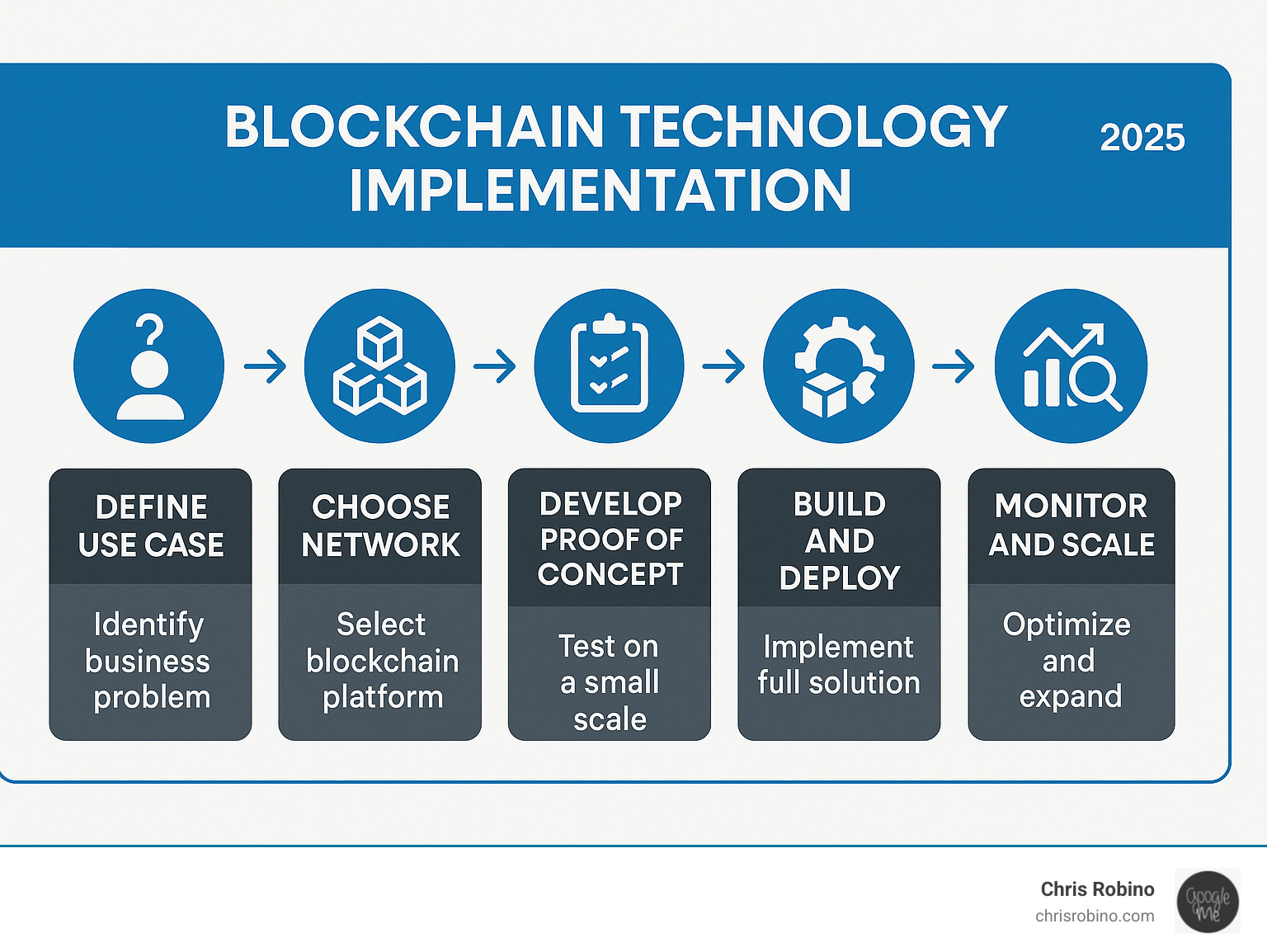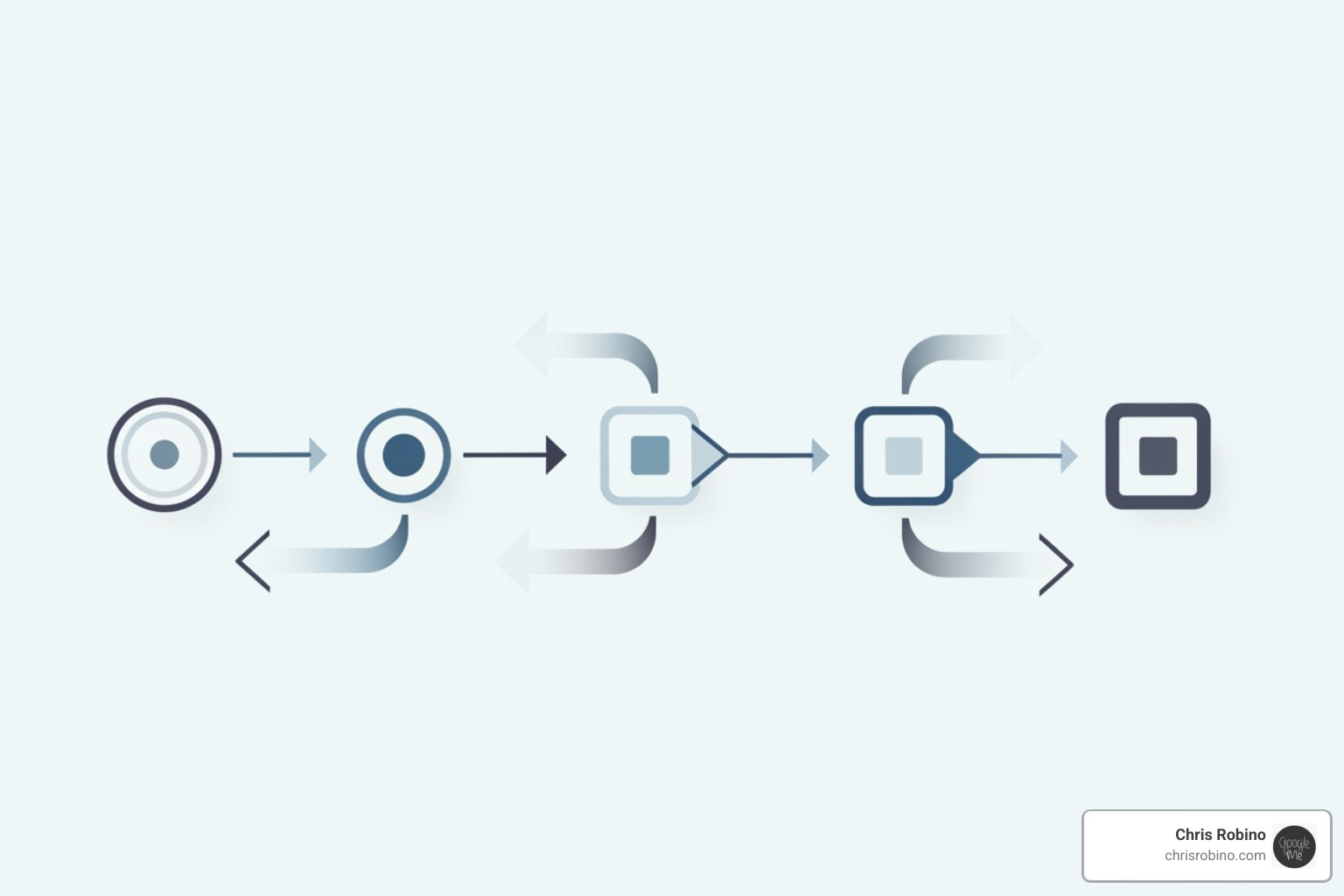Why Blockchain Technology Implementation is Changing Business Operations
Blockchain technology implementation is the process of integrating distributed ledger systems into business operations to create secure, transparent, and decentralized data management solutions. It addresses critical challenges like data security, process transparency, and intermediary costs.
Key implementation steps involve defining a use case, choosing a network, developing a proof of concept, building the full solution, and then monitoring and scaling it. Common applications include:
- Supply chain tracking
- Smart contracts for automated agreements
- Digital identity management
- Faster financial services
Despite initial skepticism, organizations are recognizing blockchain’s potential beyond cryptocurrency. Walmart, for example, used blockchain to reduce food traceability time from days to seconds. However, successful implementation requires careful planning to steer challenges like scalability limitations, integration complexity, and regulatory uncertainty.
As Chris Robino, a Digital Strategy Leader with two decades of experience in emerging technologies, I’ve guided organizations through blockchain technology implementation projects to maximize ROI. My approach focuses on integrating innovative solutions that deliver measurable business outcomes while navigating the complexities of digital change.

What is Blockchain and Why Does It Matter?
At its core, blockchain is a shared, digital ledger that is both transparent and secure. Instead of being controlled by one entity, everyone in the network has a copy. This decentralized nature creates a rock-solid, tamper-proof record of all transactions.
Information is bundled into “blocks” and chained together using cryptographic hashes. Once a block is added to the chain, it’s practically impossible to alter. The entire peer-to-peer network constantly verifies the ledger, ensuring its integrity. New blocks are added only when participants reach an agreement through consensus mechanisms. While Bitcoin was the first application, the technology’s blueprint was introduced by Satoshi Nakamoto in the 2008 paper, “Bitcoin: A Peer-to-Peer Electronic Cash System.”
So, why should your business care? Blockchain technology implementation tackles major operational headaches:
- Removing Intermediaries: It allows direct peer-to-peer transactions, cutting out middlemen like banks or lawyers. This leads to faster processes and lower fees.
- Building Trust: By distributing control across a network, blockchain removes single points of failure and builds trust directly into the system’s architecture.
- Enhancing Data Security: Cryptography and the immutable ledger make information incredibly secure and resistant to tampering.
- Promoting Financial Inclusion: It offers a way for the world’s 1.4 billion unbanked adults, according to The World Bank, to access financial services without needing a traditional bank.
Core Features of Blockchain Technology
These core features are what make blockchain technology implementation so transformative:
- Decentralization: No single entity has control, which increases resilience and prevents censorship.
- Transparency: All transactions on public blockchains are visible, fostering accountability and trust.
- Immutability: Once data is recorded, it cannot be changed, making it perfect for audit trails and permanent records.
- Security: The combination of cryptography, decentralization, and consensus makes the network highly secure against attacks.
- Programmability: You can build automated rules and logic directly onto the blockchain, enabling powerful applications like smart contracts.

The Power of Smart Contracts
Smart contracts are self-executing agreements with the terms of the agreement directly written into code. First conceptualized by Nick Szabo in the 1990s, they function like a digital vending machine: an action is automatically triggered when specific conditions are met. The Ethereum blockchain popularized their use, enabling developers to build decentralized applications.
By automating agreements, smart contracts eliminate the need for intermediaries, reducing costs, delays, and disputes. This is a cornerstone of efficient blockchain technology implementation. Key business applications include:
- Automated Payments: Instantly release funds to suppliers upon delivery confirmation or to freelancers upon milestone completion.
- Instant Claims Processing: Automatically process insurance payouts when predefined triggers, like a flight delay, are verified.
- Supply Chain Automation: Track goods, update inventory, and trigger payments as products move through the supply chain.
- Digital Legal Agreements: Transform traditional contracts into self-enforcing code, speeding up legal processes. For more, see this Introduction to Smart Contracts.
A Practical Guide to Blockchain Technology Implementation
Starting on a blockchain technology implementation journey requires strategic planning to solve real business challenges. The foundation is a solid business case that identifies a specific pain point blockchain can address, whether it’s data security, process inefficiencies, or high intermediary costs.
A crucial early step is developing a Proof of Concept (PoC). This small-scale pilot project allows you to test the technology’s feasibility and value for your specific use case before committing significant resources. From the start, you must also consider scalability planning and integration with existing systems. Your blockchain solution must be able to handle future growth and communicate seamlessly with your current software infrastructure to avoid costly roadblocks later.

Choosing the Right Blockchain Network
Selecting the right network is a critical decision in any blockchain technology implementation. Your choice depends on your needs for access, speed, and privacy.
| Feature | Public Blockchain (Permissionless) | Private Blockchain (Permissioned) | Consortium Blockchain (Permissioned) |
|---|---|---|---|
| Access | Anyone can join, read, write, and validate transactions. | Controlled by a single organization; participants need permission. | Governed by a group of pre-selected organizations. |
| Centralization | Highly decentralized. | Centralized to a single entity. | Decentralized among the consortium members. |
| Speed/Scalability | Generally slower (e.g., Bitcoin ~7 TPS) due to broad consensus. | Faster and more scalable due to fewer participants and controlled access. | Faster and more scalable than public, but less than fully private. |
| Transparency | Fully transparent; all transactions visible (pseudonymous). | Can be configured for partial or full transparency among members. | Configurable transparency among consortium members. |
| Examples | Bitcoin, Ethereum | Hyperledger Fabric (can be private or consortium), Corda | TradeLens, R3 Corda (often used in consortia) |
| Best For | Cryptocurrencies, open dApps, public verification. | Internal enterprise use, managing sensitive data, high transaction volumes. | Multi-party collaboration, supply chains, inter-organizational processes. |
Public networks like Bitcoin and Ethereum are fully open and decentralized but are often slower. Private networks, built on platforms like Hyperledger Fabric, are controlled by a single organization, offering higher speed and privacy for internal use. Consortium networks are a hybrid, governed by a group of organizations, making them ideal for industry collaboration like supply chain management. The key is to match the network type to your business requirements.
Key Steps for a Successful Blockchain Technology Implementation
A structured approach transforms a complex project into a manageable one:
- Define the Problem & Use Case: First, identify a specific business challenge where blockchain adds real value, such as improving traceability or automating compliance.
- Select a Blockchain Platform: Based on your use case, choose the right network type (public, private, or consortium) that meets your needs for speed, security, and participation.
- Develop a Proof of Concept (PoC): Start with a small pilot project to validate your assumptions and demonstrate the technology’s potential with minimal risk.
- Build and Test the Full Solution: Scale up from the PoC to a complete solution, focusing on integration with existing enterprise systems and collaborating across departments.
- Deploy and Manage the Network: Roll out the solution, preferably in phases, and establish continuous monitoring for performance, security, and user feedback.
The Role of Blockchain as a Service (BaaS)
Blockchain as a Service (BaaS) significantly lowers the entry barriers for blockchain technology implementation. BaaS providers offer cloud-based infrastructure, tools, and management, allowing companies to build blockchain applications without the massive upfront investment in hardware and specialized expertise.
Key benefits include cost-effectiveness, faster deployment, and easier scalability. By handling the complex underlying infrastructure, providers let your team focus on the business application itself. For many organizations, BaaS is the most practical and efficient path to adopting blockchain technology.
Navigating the Landscape: Benefits and Challenges
Blockchain technology implementation is not a magic bullet; it’s a powerful tool with both significant benefits and real challenges. A successful implementation depends on a clear-eyed assessment of both sides, much like understanding a high-performance vehicle before getting behind the wheel.
Organizational Benefits
When implemented thoughtfully, blockchain delivers transformative results:
- Increased Efficiency: Smart contracts automate manual processes and agreements, drastically reducing time and effort.
- Improved Security: Its core architecture—cryptographic linking, decentralization, and consensus—makes data highly resistant to tampering.
- Greater Transparency: A shared, real-time ledger ensures all participants work from a single source of truth, building trust.
- Improved Traceability: Blockchain provides an unalterable audit trail, perfect for tracking products from origin to destination.
- Cost Reduction: By removing intermediaries and automating tasks, organizations can significantly reduce costs associated with fraud, manual validation, and operations.

Significant Challenges in Blockchain Adoption
It’s crucial to plan for these potential problems:
- Scalability Issues: Public blockchains like Bitcoin (around seven transactions per second) can’t match the throughput of traditional systems like Visa. This can be a deal-breaker for high-volume applications.
- Energy Consumption: Proof-of-Work blockchains consume vast amounts of energy, a major concern for sustainability-focused organizations.
- Regulatory Uncertainty: The legal landscape for blockchain is still evolving, creating compliance challenges, especially for global operations.
- Interoperability: Different blockchain networks often cannot communicate with each other, limiting the technology’s potential.
- Data Storage Size: The ledger grows continuously—the Bitcoin blockchain is over 600 GB—requiring significant storage resources.
Overcoming Common Blockchain Technology Implementation Problems
These challenges are manageable with the right strategy:
- Adoption Resistance: Public skepticism (e.g., 44% of Americans say they’ll never buy crypto) often stems from unfamiliarity. Overcome this with pilot projects that demonstrate clear, tangible value and ROI.
- Lack of In-house Expertise: Blockchain requires specialized skills. Partnering with experienced providers or using Blockchain as a Service (BaaS) can bridge this gap effectively.
- Security Vulnerabilities: While the core technology is secure, the implementation is not immune to risks. Robust access controls, fraud detection, and regular security audits are essential.
- Illicit Activity Perception: Early associations with illicit use persist, though such activity is a tiny fraction (0.34% in 2023) of total volume. Counter this by focusing on legitimate, transparent use cases and adhering to regulatory best practices.
Blockchain in Action: Real-World Use Cases
The true power of blockchain technology implementation is evident in its real-world applications. Beyond its origins in cryptocurrency, blockchain is a versatile tool reshaping industries like finance, healthcare, real estate, and even government.
For example, Estonia uses blockchain on a national level to secure critical government data. In finance, major exchanges facilitated over $9.5 trillion in transactions in 2021. But two areas where blockchain’s impact is particularly profound are supply chain management and digital rights.
Changing Supply Chain Management
Supply chain management may be blockchain’s killer app. It solves long-standing issues of transparency and traceability with remarkable efficiency.
- Product Traceability: Blockchain creates a permanent, transparent record of a product’s journey. During an E. coli outbreak, Walmart used its Hyperledger Fabric-based system to trace lettuce from farm to store in just 2.2 seconds—a process that previously took weeks. This speed saves money, protects consumers, and supports producers.
- Combating Counterfeits: Industries from luxury goods to pharmaceuticals can provide consumers with verifiable proof of authenticity, making it nearly impossible to pass off fake products.
- Improving Transparency: Platforms like TradeLens provide a shared, tamper-proof ledger for all parties in the shipping process, eliminating disputes and building trust.
- Ethical Sourcing: Companies like Ford and Renault use blockchain to track raw materials and ensure compliance with ethical sourcing standards and regulations. For more, see this scientific research on Blockchain in supply chains.
Revolutionizing Copyright and Digital Rights
For the media and entertainment industry, blockchain technology implementation offers powerful solutions for protecting intellectual property and ensuring fair compensation for creators.
- Intellectual Property Tracking: Blockchain provides an immutable, verifiable system for managing IP. Today, 80% of the world’s patents are held in a blockchain database, improving valuation and accessibility.
- Automated Royalty Distribution: Smart contracts can automatically distribute payments to artists and creators based on real-time usage data, eliminating the delays and disputes common with traditional royalty systems.
- Copyright Verification: The technology acts as an unalterable timestamp, providing creators with definitive proof of creation and ownership.
Industry leaders like Sony Music are exploring blockchain to create a more transparent and equitable system for creators. Their work, as detailed in various industry articles, shows how the technology can empower artists by creating direct, transparent relationships with their audiences.
Conclusion
We’ve seen how blockchain technology implementation is evolving from a niche concept into a powerful business tool. From securing national data in Estonia to streamlining supply chains at Walmart, blockchain is delivering measurable value by enhancing trust, transparency, and efficiency.
While challenges like scalability and regulatory uncertainty exist, they are not impossible. Successful organizations approach these obstacles strategically, starting with clear use cases and building robust solutions. The benefits—increased efficiency, improved security, greater transparency, and cost reduction—are compelling reasons to move from curiosity to implementation.
Successful blockchain technology implementation is not about chasing a trend; it’s about solving real business problems to create a lasting competitive advantage. For large enterprises, it represents a foundational shift, much like the internet did decades ago.
As a specialist who has guided numerous organizations through digital change, I know that the right approach can open up tremendous value. Blockchain technology implementation requires careful planning and expert guidance to steer its complexities successfully.
Ready to explore how blockchain can fit into your digital strategy? Let’s discuss how to build solutions that deliver real business impact.
